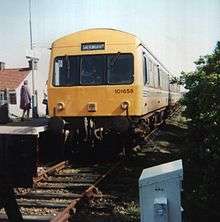Railway stations in Cromer
The fishing port and holiday resort of Cromer in the English county of Norfolk has had a rail service since 1877. It was served by three railway stations for many years, and is now served by two. Cromer Beach station, which opened in 1887, was renamed Cromer following the closure of the other early stations.
Cromer High station, on the outskirts of the town, was opened in 1877 as the terminus of the Great Eastern Railway main line from London. It was followed in 1887 by Cromer Beach station, on the rural Midland and Great Northern Joint Railway (M&GNJR). Cromer Links Halt station, on the little-used and now closed Norfolk and Suffolk Joint Railway line to North Walsham Town via Overstrand and Mundesley, was opened in 1923.

Following a reduction in traffic caused by Cromer's decline in popularity as a holiday destination after World War II, and the closure of many Norfolk railway lines in the 1950s, a decision was made to concentrate all passenger traffic into a single station. Although Cromer High had far better facilities, it was inconveniently situated on the edge of the town. Therefore, all passenger services were diverted into Cromer Beach (renamed Cromer) and the other stations closed. Following growth of the town as a commuter town to Norwich, a new station called Roughton Road opened in 1985, near the site of the former Cromer High.
Cromer railway station
Because the Midland and Great Northern Joint Railway (M&GNJR) line approached Cromer from the west, following the coastal clifftops, it avoided the steep escarpment which had prevented the earlier line from Norwich running all the way into the town. Consequently, it became possible to build a far more conveniently located station, near to the town centre and the beach. The station opened as Cromer Beach on 16 June 1887 and was renamed Cromer on 20 October 1969, following the closure of Cromer High station in 1954. It is 26 miles 52 chains (42.9 km) down the line from Norwich.
Roughton Road railway station
Roughton Road was opened on 20 May 1985, to serve the new housing developments in the area. It is on the southern edge of Cromer, near the junction for the disused Cromer Tunnel leading to the former Norfolk and Suffolk Joint Railway line, about 200 yards (183 m) from the site of the former Cromer High station.
Former stations
Cromer High railway station
Cromer High railway station was the first station opened in Cromer, situated to the south on the outskirts of the town on a steep escarpment.[1] Built initially by the short-lived East Norfolk Railway, the station (along with the line) was incorporated into the Great Eastern Railway, who had operated the services from the beginning.[1] It served as the terminus of Great Eastern Railway services from London and Norwich. Initially named Cromer on opening, it was renamed Cromer High on 27 September 1948.[1]
Cromer Links Halt railway station
Cromer Links Halt (located at TG232409) was a railway station on the outskirts of Cromer. It was on the now disused Norfolk and Suffolk Joint Railway line between Roughton Road Junction and Overstrand station. It opened on 9 July 1923, only to close thirty years later on 7 April 1953.[2]
References
- Catford, Nick. "Cromer High". Subterranea Britannica. Retrieved 21 December 2007.
- Butt (1995), p. 72
Bibliography
- Adderson, Richard; Kenworthy, Graham (1998). Branch Lines Around Cromer. Midhurst: Middleton Press. ISBN 978-1-901706-26-0.CS1 maint: ref=harv (link)
- Butt, R. V. J. (1995). The Directory of Railway Stations: details every public and private passenger station, halt, platform and stopping place, past and present (1st ed.). Sparkford: Patrick Stephens Ltd. ISBN 978-1-85260-508-7. OCLC 60251199.
- Joby, R. S. (1985). East Anglia. Forgotten Railways. 7. Newton Abbott, Devon: David & Charles. ISBN 0-946537-25-9.CS1 maint: ref=harv (link)
- Jenkins, S. C. (1989). The Cromer Branch. Headington, Oxford: The Oakwood Press. ISBN 0-85361-384-2.CS1 maint: ref=harv (link)
External links
- Map sources for Railway stations in Cromer
- Train times and station information for Railway stations in Cromer from National Rail